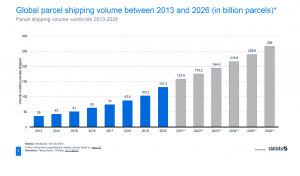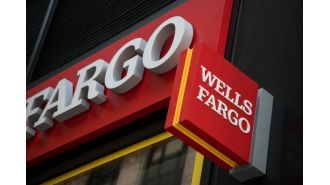Returns Driving Retail?
In the afterglow of the Pandemic wherein the whole world was on line buying “stuff” the issue of returns has become a gigantic consideration.
Look at the number of parcels handled worldwide during the time period 2013 – 2026 (estimated). It is truly gigantic. Click on the graph to see it at a usable scale.
So, what about the returns, Big Red Car?
Each parcel noted above (which may have more than one item in it) is susceptible to being returned. Here are some interesting facts:
1. In 2022, United States ecommerce retailers experienced a 16.5% return rate equating to more than $800,000,000,000 in lost revenue. I have seen much higher numbers on the return rate.
2. More than 16.5% of all ecommerce purchases are returned with some folks being data-identified and considered “heavy returners.”
3. One of the biggest culprits are what is called “bracketers” or “try-to-buy” which signifies customers who buy a product in multiple sizes, try them all on, and return the ones that don’t fit whilst retaining the one that does fit.
Buyer buys three sizes, keeps one, returns two, and seller has to deal with the aftermath including the cost of movement and the re-stocking, if the item can be, in fact, re-stocked.
Companies have a huge dilemma here — do they identify and then exclude “bracketers” from their promotional programs?
4. More than 60% of digital buyers check the return policy of the seller before purchasing an item and 40% will pass if they do not like it. Return policy is a gateway control function.
5. Half of buyers expect the seller to provide at least 30 days of free returns and more than 70% of buyers will pass on a purchase if the buyer has to pay for the return.
So what is a seller to do, Big Red Car?
This is where it gets interesting, dear reader, as sellers are all over the playing field.
1. Some sellers are making their return terms more liberal believing that a liberal return policy will draw more customers at the expense of competitors.
More than 30% of etailers send a return label in the original delivery box thereby streamlining the process.
Zappos attacked the issue head on offering 365 days to return items plus the refund is issued as soon as the courier scans the return package.
2. Some sellers are beginning to charge for returns, but will this impact the sales? I personally believe that this will start with nominal — $5 — fees and accelerate.
3. Some folks like Amazon are providing easy to use locations — like their Whole Foods stores — and making the return paperless using phone scannable documentation only. Talking to you, QR Codes.
I have used this service and it is faster than buying organic bok choy.
4. Almost every company has deployed some form of return management software — deployed tech, is collecting return data, and trying to find a way to reduce returns which may entail better information and visuals on their sales sites.
Returns have become the ugly sister of fulfillment.
Where sellers obtain a reason for the return — not all sellers do — the largest attribution is that the product was not as described.
5. Companies like Uber are getting into the game wherein they come pick up a package for $5, drop it off at the proscribed return location (could be UPS, USPS, Whole Foods, et al), and then provide a picture of the drop off.
By the way, the retailers end up sending more than 5,000,000,000 tons of returns to landfills. I could not believe that number until I saw it in multiple locations. Seems incredible to me.
Bottom line it, Big Red Car
Return policy for etailers is a huge consideration and a gatekeeper function. You may lose a customer before they even look at your product offerings with the wrong policy.
This will be a continuing problem until it isn’t.
But, hey, what the Hell do I really know anyway? I’m just a Big Red Car.
Have a great weekend and call somebody you haven’t spoken to in a long, long time even if it is your Momma. Joy to the world from all corners.







